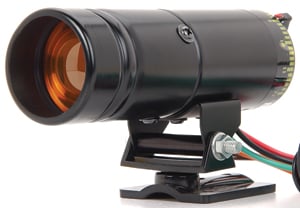
I have a shift light like this one. The LED lights up at a specific RPM. I removed the single LED and connected a string of LEDs, but they're very dim when powered by the shift light. How can I make them brighter? Relay? Transistor? How should it be wired?
I tried a relay but couldn't get it to work.
Thanks!
Here's a diagram to help with visuals.
I have the LED hooked up to a 12v power source through a circuit board. The LED is only getting 6v from the circuit board. How can get 12v to the LED?
Keep in mind I can't eliminate the circuit board, I need it to tell the LED when to turn on.

I'd change the circuit board. Remove it, or change internal components.
You can search for circuits that switch 12V loads from any input voltage. It may be a simple as a transistor.
WRT the original gear change LED, if it was originally a white or similar higher voltage LED, then only use strings of one but no more than two red series LEDs.
Maybe reducing the existing series resistor is all that is required for the original LED to increase brightness... that depends on its specs and desired life, and switch capability.
Otherwise, simply put, replace the LED with a brighter version of suitable color. (Suitable color meaning both from a LED voltage POV as well as any optical/lens filtering.)
Maybe it's a typical 20mA LED in which case maybe a 40-50mA version can be used. That'll require reducing any series resistor (eg solder another in parallel) and assumes whatever switching can handle the current.
In general you need to establish the original LED characteristics. Knowing or measuring the supply voltage and reading the series resistor value and either measuring LED voltage else knowing its color is often sufficient for that.
Another aspect is what transistor or chip turns on the LED - can it handle higher LED currents? (You can replace a blown transistor but probably not a blown chip.)
The above is based on LEDs with series resistors and not current limiters or converters.

